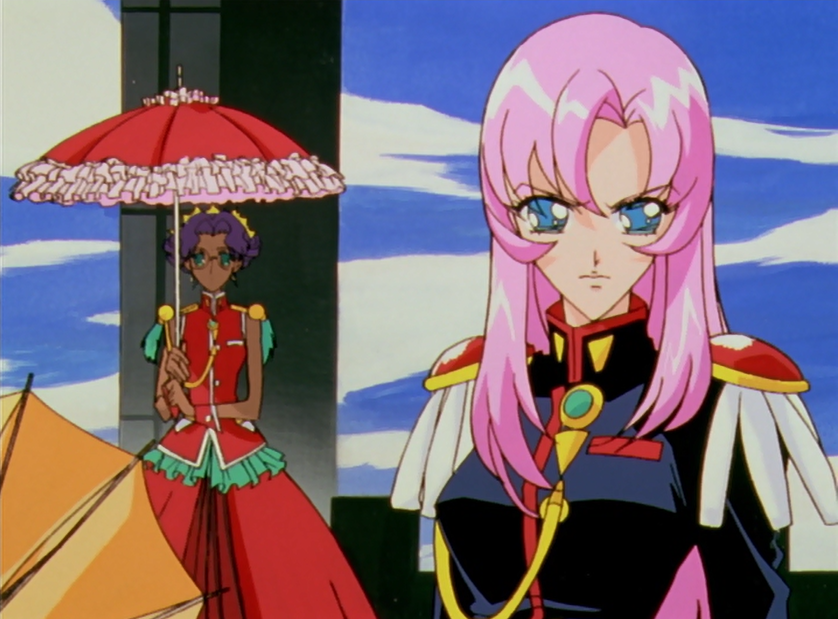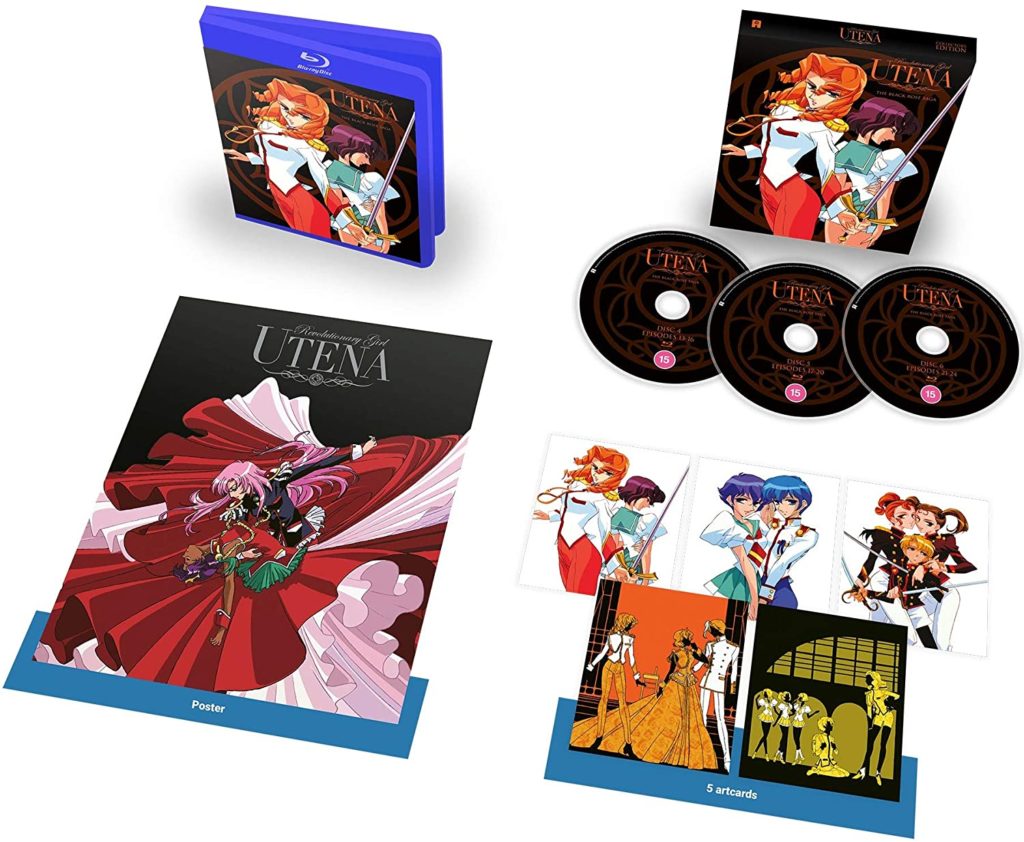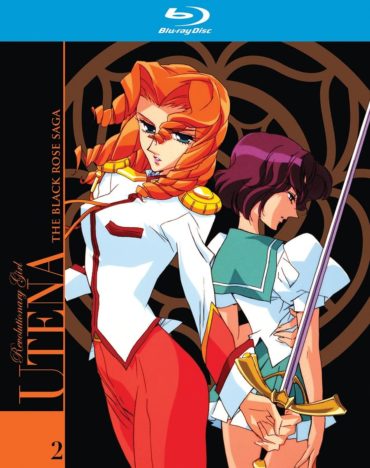Revolutionary Girl Utena: Part 2 Review
Utena Tenjo has won all her battles against the student council and remains engaged to the Rose Bride, Anthy Himemiya, but things are far from over. Just as Anthy decides to introduce Utena to her older brother, Akio Ohtori, who is acting-chairman of the school; a new wave of duellists wearing a black rose ring come forth to challenge Utena. But these duellists are much more sinister than the student council; instead of wanting to own Anthy, they want to kill her. But with the black rose seemingly possessing innocent people across the school, can Utena defeat them all?
This set, covering the Black Rose Saga, contains Episodes 13 to 24, and, like the previous set, it seems to take the first episode of the next arc into this set, so these episodes basically top and tail it with clip/montage episodes. This seems like a weird choice on paper, but after watching all the episodes and considering the symbolism so far, it’s clear what it’s trying to do. In my review for Part 1, I noted that the series’ first sets of duels deconstructed the outward/physical demonstrations of what Utena considers a ‘prince’ should be, such as chivalry and kindness. These are reflected upon in Episode 13, ‘Tracing a Path’, which recaps each of the duels and gives them all names and defines their purpose in similar ways, such as adoration, reason and conviction. This clip show episode not only lays out where we’ve come so far but also gives us our first glimpse of ‘End of the World’ and the ‘Power of Dios’ that have been mentioned frequently but not shown. It’s a foreboding clip show that not only catches the audience up, but opens the path to a whole new chapter, showing that everything Utena has gone through so far has, seemingly, been playing into someone else’s hands. The last episode, however, has a very different vibe to it; it’s another clip show but with a more comical twist, with Tsuwabuki – the loyal young boy who’s at Nanami’s beck and call – suddenly injured and his secret diary is read by the main cast out loud, recapping Nanami’s actions up to this point. It seems, on the surface, to be nothing more than just a summary of the more comical episodes of the show, but it plays into this arc’s theme: our memories, how reliable they really are and why, sometimes, it’s dangerous to allow them to become the sole reason for our identity.

The Black Rose Saga is a two-sided coin. On one side it plays much more strongly into typical Magical Girl/Shojo tropes; we have the new villain, Souji Mikage, who resides in the shadows and manipulates the students who are suffering emotionally and persuades them to become duellists to attack Utena and kill Anthy. It’s similar to the likes of Sailor Moon, where the villains use ordinary people to plant enemies inside them or use them as resources to power up the ‘monster of the week’ type of deal. It also has Utena not simply rely on her own sword skills and physical strength to defeat her opponents. Since she’s now up against possessed students and people she cares about, we see a lot more of her quick thinking and prowess in order to strike the black rose from their chests and set their minds to normal again. On the other side of the coin however, this saga is noticeably darker than the first; the music is more sinister, Anthy and her brother Akio seem to have something between them that’s far bigger than the picture we’ve been shown so far, and having the arc villain whispering in the student’s ears to ‘go deeper’ as they bare their souls, only to be taken advantage of and find themselves in the heart of the villain’s lair, can send a chill down your spine. Each opponent has a memory from the past, or an idea of a person, that they’ve clung to their whole lives and when it’s challenged or suddenly about to break, it’s then that Souji twists their perceptions and promises them they can ‘Revolutionize the world’ if they become a duellist, to shape the world the way they want to. It’s not too dissimilar to Utena; she’s become a prince due to a memory of someone comforting her, and it’s the basis for her whole identity so far. But we’ve seen how fragile it is already, with Episode 11 of the Student Council Saga, where Touga manipulated Utena into thinking he’s the prince from her memories, and knocked her confidence as a result. It’s this inner conflict that takes a while to put the pieces together, but at the end of this saga, it feels cathartic that we’ve now looked deeply inwards and outwards of what it means to be a ‘prince’, and now it’s time to see what the final saga has in store for us.
Of course, given Kunihiko Ikuhara’s track record for surrealism and outlandish symbolisms, I’ve probably missed a ton of information or themes on the way, but that’s also part of what makes Utena not only highly enjoyable just to watch for the story, but also enjoyable to deconstruct on repeated watches. There are, however, a couple of slip-ups and low points in this arc. One is due to the symbolism itself in places, such as in Episode 16 where Nanami is so desperate to be the centre of attention that she wears a high-priced cowbell thinking it’s the latest fashion accessory and turns into a cow as a result (Get it? ‘Cos if you follow fashion trends, you’re following the herd? Cow herd? Get it yet??!) and in Episode 22 where we’re given a flashback into the arc’s villain’s backstory, and Mr Ikuhara felt it was necessary to have actual hands pointing at various parts of the scenes he deemed important. I don’t know if it was done as a joke, or was a random director’s choice, but even to someone who isn’t quick to pick up on symbolism, I felt a bit too handheld during the episode and it took me out of it rather than immersing me in it.

Animation continues to be provided by J.C. Staff, and there’s less noticeable instances of recycled backgrounds and looped animations, but there are a few instances where the budget was spread thinly, or a trick didn’t work the way I think the show intended. For example: there’s a scene where the villain turns his face very slowly and menacingly towards Utena, but the animation itself is too stilted and it looks more like a mistake. But considering that the combat segments do get more complicated and fancier in this saga, it’s more forgivable that, where it matters, the animation and on-screen action continues to be smooth and elegant.
It should be noted that when this series was first licensed in the US, the first 13 episodes were dubbed and released in 1998, but the following 26 episodes weren’t released until 2002/2003, due to licensing issues. That means that there’s a big gap in between releases for the voice actors to gain more experience, and you can hear it in the performances in this set. Although I still prefer the Japanese dub overall, the English cast are certainly much more in-tune with the characters they are performing and less rookie mistakes are made as well.
On-disc extras include a gallery of the concept art, promos, and there’s an interview with the director himself on the last disc. There are two parts of the interview but they seem to be part of an even larger one that I hope continues into the next set because both parts of the interview we’ve got are a mere 3 minutes’ long each, if that. If you ordered the collector’s edition of this set, you’ll also get 5 new art cards and a poster; the art cards are the same as the menu characters across the discs, whilst the poster is over the box-set cover art.
The Black Rose Saga is a darker turn for the series and leaves in its wake a huge question mark drenched in ominous music for where the series could go next. There are a few stumbles in this saga’s run but the series continues to prove why it’s a beloved classic to begin with. Don’t miss picking up the gorgeous Blu-ray today.



